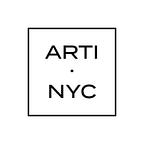Rites of Visualization
We talked to Pedro Gramaxo, a Lisbon-based minimalist, to see how he managed to continue building his large scale site-specific installations through 2020.
ARTI.NYC: 2020 is coming to an end, but the pandemic is still flourishing. Can you say that you got used to this new world? What has dramatically changed in your daily artistic practice?
Pedro Gramaxo: Not getting used to it, but adapting; I strongly hope this is temporary.
Since we were locked for most days due to my work’s format — 2020 was a time to reinvent processes. I had to keep the workflow — to research materials and construction technics, photographic gear, videocall fellow artists, and scatter locations close to Lisbon through Google maps. It is/was a weird relation with reality because I was/am guiding myself through a digital reality —
colors, shapes, dimensions, everything was fictional and roughly captured on the computer screen.
I built pieces (when I was able to travel) according to the references found on google maps, so the pieces were made according to “unreal” and insubstantial contexts.
I started to call these moments — Rites of Visualization — I was putting my process in the hands of an un-updated online geographic page. When the moment came to travel and discover these locations, the rite was at its strongest moment because every place was unpredictable.
At the same time, because of these constraints and the importance of the moment of the on-site work, I think I have never felt more connected to the natural context.
AN: Tell us more about the obstacles you faced because of the COVID-19.
PG: (Laughing)
Everything was an obstacle!
Every country was under different restrictions, case numbers, and preventive care.
In Portugal, we had 3-month mandatory confinement (March to May), and we were only able to travel to other cities during some weekdays, so on weekends, we had and still have a mandatory lockdown.
Of course, for me, it has been a terrible moment of “standby,” almost all of my artworks require a natural context, and I was restrained!
My studio is 8 km from my house, on the outskirts of the city! All of my planned projects for 2020 were canceled. So, everything could only be developed in an imaginative and adventurous way.
To successfully accomplish these Installation Rites, my team and I had to be bold and creative.
We traveled before sunrise and after sunset — with a dismantled installation in our trunks — so we wouldn’t get caught outside our residence area photographing the artworks.
Illegal activity! (More laughs). We pulled it off!!!
AN: Seems like you had a fun and productive year. Do you think isolation is the best time for an artist?
PG: Definitely not the best time, but it was an atypical kind of good.
Strangely enough, I had two group shows in Lisbon, one art fair (CADAF), six large-scale installations (Dimension, Landscape, and Portrait Series), a short film (Bright Hour series), and my sales remained basically the same. Breaking it down into two obvious aspects, we had the physical and the psychological.
When you are imposed with physical restrictions, there is a sudden urge to move, create, and develop projects countering those impositions.
I guess the mind works in mysterious ways — I was more absorbed in my studio work.
In another way, it was a good time for people to stop, self-evaluate, analyze, and rethink everything, such as artistic path, career goals, media evolution, and so on. For many fellow artists and myself, this was that moment. Because if you don’t have the initiative, time, or courage to do it yourself, you can only be forced to do it.
AN: Your Mx* project is about sustainability. Why did this become so important to you at this time?
*Pedro Gramaxo invented his own length unit called “Mx” that allows him to cut standard size wood panels without leftovers. He measures all of his installations in “Mx,” not meters.
PG: During the isolation, I focused on analyzing what I was doing and where I was going. I felt the need to work more seriously on the “Mx” unit and to put it out there for people to know it existed and I was respecting it.
The sustainable principle has always been present in my process.
When I started my path in the art world, my first studio was a small space inside a warehouse belonging to the cinema industry, so I could reuse large scale materials and leftovers from sets and temporary decorations. This was how I could build from a young age, pieces the size I wanted without wasting more materials and spending vast amounts of money. This beginning completely changed my mindset. Now, I try to make the most of it by having my “matrix” as a guideline for eco-friendly aesthetics.
AN: Do you think the world is dealing with the pandemic smartly? What would you change?
PG: I think so, yes!
Despite my ignorance in many professional areas that are now affected by Covid, my naive contribution would be to promote more outdoor cultural events so as not to stagnate the cultural media.
AN: How can artists and society help each other at this time?
PG: Connect, bond, work together in new formats, such as digital or in news contexts for art.
Obviously, keep curious and interested. This is when artists need appreciation and value the most, keep contacting, buying, and sharing.
Thank you!
